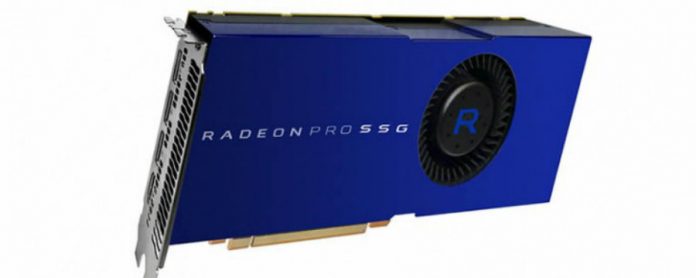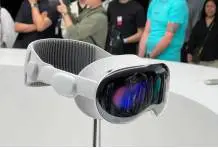
Anaheim, Calif. – AMD (NASDAQ: AMD) launched a new graphic processing technology that could accommodate up to 1TB of storage and could revolutionize the task of image-rendering. The tech, called Radeon Pro Solid State Graphics (SSG) was introduced at the SIGGRAPH 2016 computer graphics and augmented reality convention in California.
SSG would be a direct competition of the Pascal-based GPUs from Nvidia (NASDAQ: NVDA). Last Tuesday on SIGGRAPH trade show they presented Quadro P6000, claimed to be the most advanced graphic card around. SSG dedicates one terabyte frame buffer directly on the GPU to eliminate this problem.
Keep in mind that graphic latency may rise when chunks of data are processed individually and then merged. Optical latency could also increase when data from an external drive (including a cloud service) is combined with a computer’s internal memory.
Whichever the case may be, SSG technology acts as a frame buffer and deals with rendering task locally, rather than having the computer pulling the data over from the system memory,
This is why the new architecture represents a groundbreaking approach for professionals. As Advanced Micro Devices boast, “SSG is all about the impossible.”
8K videos in real-time, at 90 frames per second
AMD explained their new graphic cards would start at a full terabyte of memory, ten times the capacity of their existing GPUs.
The company states that such improvement in memory capacity enables much higher levels of performance, including real-time heavy CGI work with 8K videos, high-resolution rendering, VR content creation, computational engineering (CAM/CAD programs), oil and gas exploration, medical imaging, and life sciences.
In a demonstration at the SIGGRAPH show, AMD showed the unit handling video at 90 frames per second with 8K resolution. In comparison, mainstream GPUs are capable of 17FPS at 8K resolution.
Cleverly said by Antal Tungler, senior manager of public relations at AMD: “If only they had a solution with enough memory to get the job done, they could open new horizons of knowledge or execute game-changing business strategies.”
Radeon Pro SSG will be the first in this line of graphic cards, and it will be connected to a PEX8747 bridge chip. Furthermore, it’ll have integrated two PCle 3.0 M.2 slots that allow for more accessible PCI Express storage. It can also reach up to 1 TB of NAND flash memory to increase frame buggering massively for high-end rendering projects.
Reaching for new possibilities
In addition to addressing the challenge in high-latency graphical applications, AMD said the SSG opens up the possibility to create entirely new, complicated and endearing requests for the first time.
On the matter, Tungler suggested futuristic 3D-video software’s that could create, say, a real-time beating human heart during cardiac surgery.
“One of the most challenging constraints faced by GPU computing applications is the inability to access terabytes of data,” said Raja Koduri, senior vice president and senior chief architect of Radeon Technologies Group.
Koduri explained the Radeon Pro SSG would speed-up applications with large data pools, and also enable new application experiences by utilizing data persistence of non-volatile memory. This should be a significant advance in computer applications.
Radeon Pro SSG is already open for developers for a price close to 10 thousand dollars, while the full availability of the new tech would be early 2017.
All in all, much like Nvidia’s Quadro Cards, Radion Pro SSG is not designed for the average consumer or, even less, gamers. The average Steam player goes around with 4GB of VRAM, and high-end games such as The Witcher 3 requires but 2GB of VRAM to run in full quality.
We want to express our biggest thanks to our partners, our attendees, and everyone who watched #AMDCapsaicin 2016.https://t.co/pzLgPfooo4
— Radeon Pro (@RadeonPro) July 26, 2016
One TB of VRAM or 12 TFLOPS of single precision performance would be hard to consider This is why both models have such a professional focus.
AMD family just got bigger
AMD also announced their new Radeon Pro WX series. These are workstation-aimed cards designed to be optimized for creators, whether they develop games, movies, animations or product designs.
The units are based on AMD’s Polaris architecture and can fit in the affordable category.
The series is made by the WX4100, WX5100 and the WX7100, each obtainable for less than $1000, compare to the older FirePro models which launched with prices higher than $3000. WX series can support up to four 5K displays at the same time, and are capable of creating VR content.
Eye-catching 4K display powered by a single W9100 card at AMD booth 621 astounds #SIGGRAPH2016 #AMDCapsaicin pic.twitter.com/JmQdRtv1WQ
— Radeon Pro (@RadeonPro) July 26, 2016
The older brother, WX7100, includes 8GB of VRAM, 2304 stream processors and can deliver 5.9 teraflops of double precision performance. This piece is better used for demanding media PCs.
WX5100, built for real-time design and engineering software, delivers 5.2 teraflops of single precision performance, has 8GB of VRAM and 1792 stream processors. The modest one of the family, WX4100, includes 4GB of VRAM, 1024 stream processors and 2.4 TFLOPS of single precision performance. It is more than enough for small workstations.
For a low price, WX series still enters the high-end products market and the ever-growing demand for VR-capable graphic cards.
See what the Radeon™ Pro SSG can do to help drastically improve professional workload enablement #AMDCapsaicinhttps://t.co/ZkcfffSScN
— Radeon Pro (@RadeonPro) July 26, 2016
Source: Extreme Tech










